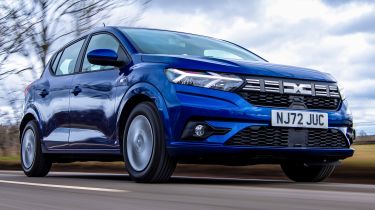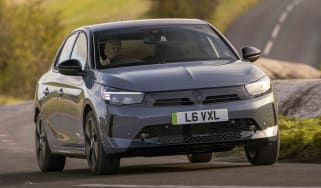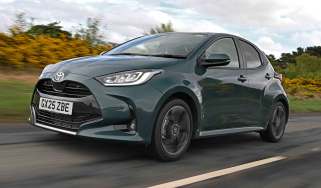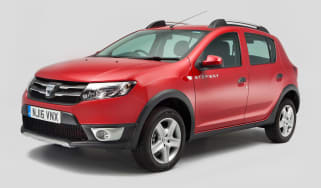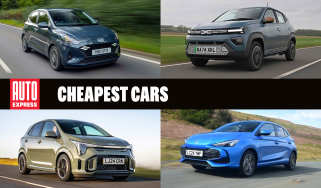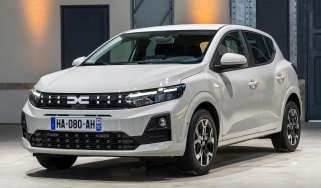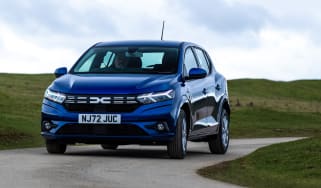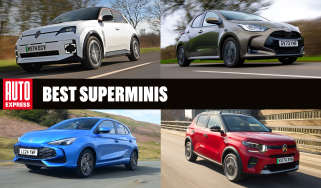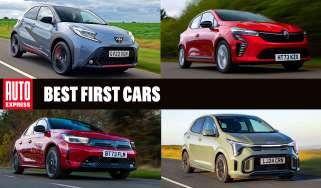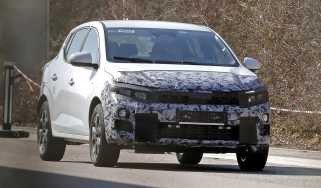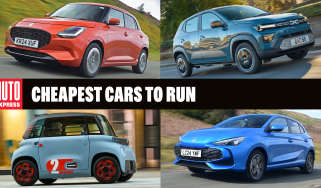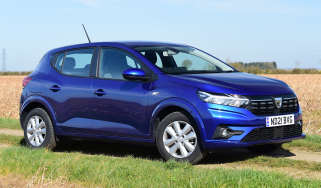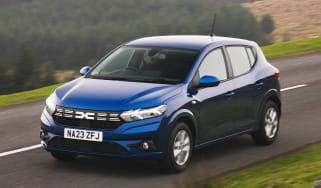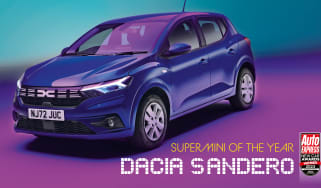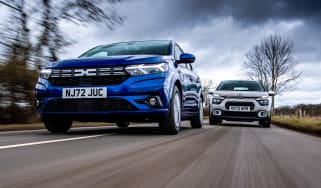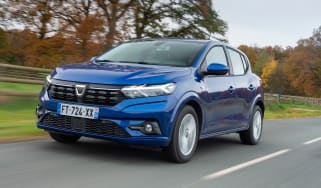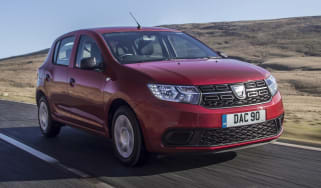Dacia Sandero review
A spacious interior and refined driving manners show there’s more to the Dacia Sandero than just the price

Dacia claims its focus is making quality new cars affordable, and the latest Sandero is the epitome of that mission statement. The value-focused supermini remains one of the UK’s cheapest cars, even after subtle refinements to the Sandero’s styling, cabin, running gear, and specification.
The Dacia Sandero continues to offer great practicality for cost-conscious buyers. It even makes sense for those choosing the higher specification versions, because its low running costs shouldn’t leave them out of pocket. They say the most simple ideas are often the best, and despite not being one of those trendy small SUVs (there is a pseudo-SUV version called the Stepway, if you want), Dacia’s well-judged, great-value supermini is right up there with the best in the class.
About the Dacia Sandero
Dacia was founded in 1966, but the Romanian carmaker didn’t officially launch in the UK until 2013. It has always been laser-focused on offering new levels of family car affordability – in fact, its first TV advert proudly declared: “We don’t do frivolity; function’s our thing,” before stamping the £5,995 Sandero list price across the screen. For those on a budget who didn’t want to deal with a used car's potential wear and tear costs, the Sandero was a hard proposition to resist.
Used - available now

2024 Dacia
Sandero
13,238 milesManualPetrol1.0L
Cash £11,857
2022 Dacia
Sandero
10,011 milesManualPetrol1.0L
Cash £10,990
2022 Dacia
Sandero
23,170 milesManualPetrol1.0L
Cash £9,248
2022 Dacia
Sandero
43,828 milesAutomaticPetrol1.0L
Cash £10,600Dacia has sold over eight million cars worldwide, including 250,000 in the UK alone, and things are looking even better for customers with the latest, third-generation Sandero supermini. The brand has implemented a raft of engineering changes and tech updates that give the Sandero a modern, more up-to-date feel, yet crucially, prices are still extraordinarily low. This package has only been made to look more appealing because, like the brand’s entire lineup, the Sandero has received sharper styling, a revised headlight design, and an interlinked Dacia logo.
With a fresh look and a little extra finesse, the Sandero poses serious questions for buyers looking towards pricier rivals. The Skoda Fabia, Volkswagen Polo, Hyundai i20 and closely related Renault Clio all rival the Dacia for size, but can’t compete on price, with an entry-level version of all four still costing thousands more than a top-spec Sandero. The only similarly sized supermini that comes close to the Sandero’s value package is the base Citroen C3, although the Sandero still undercuts the C3 on price by a few hundred pounds.
The Sandero range starts from a little under £14,000 in Essential spec. This gets you air-con and remote central locking, plus cruise control, DAB and Bluetooth connectivity, but no touchscreen. It does not have an alarm or electrically adjustable and heated door mirrors like the base C3 You!, but the entry-level Sandero does have the added convenience of rear parking sensors to make parking that little bit easier.
Mid-range Expression trim is the best value Sandero in our opinion, despite costing around £15,000. For that, you get some smart grey fabric accents and some upgraded upholstery that gives the interior a classier feel, along with an eight-inch touchscreen with Android Auto and Apple CarPlay connectivity, plus a rear-view camera.
The top-of-the-range Journey comes in at around £16,000, and features sat-nav, climate control, front parking sensors, and a blind spot warning system.
If you're after a little extra SUV style, the Sandero Stepway comes with a raised ride height and rugged exterior trim for only a small price premium. The trim levels remain largely the same as the regular Sandero, besides some Stepway-specific seat fabric and some exterior styling tweaks. The only major change is that the top-of-the-range Sandero Stepway is called Extreme rather than Journey.
All Sandero models have a 1.0-litre turbocharged engine in TCe 90 or TCe 100 Bi-Fuel forms. The former is the more astute choice anyway, with 89bhp, a useful extra slug of torque and fuel economy of up to 53.3mpg.
The TCe 100 Bi-Fuel unit is a great idea for taking advantage of the cost-saving benefits of LPG tech. Choosing this version means you can’t specify a spare wheel, but you gain a 40-litre LPG fuel tank instead, giving this version an exceptionally long range. However, you’ll need to live near a filling station that offers such fuel; otherwise, it becomes inconvenient to go out of your way to find fuel.
The TCe 90 and TCe 100 Bi-Fuel cars are paired with a five-speed manual gearbox, but the TCe 90 is also available with a CVT automatic if you go for the priciest Journey trim. Choose the SUV-inspired Sandero Stepway, and you’ll get a six-speed manual as standard, with the option of a CVT auto on the most expensive Extreme version.
Engines, performance and drive
The third-generation Dacia Sandero is wider than the previous model and utilises the CMF platform from the Renault Clio, which is lighter and stiffer than the old car’s. It by no means transforms the Sandero into a car designed for driving enthusiasts, but the underpinnings bring improved ride comfort that makes the Sandero decent to drive around town and a competent motorway cruiser in either TCe 90 petrol or TCe 100 Bi-Fuel guises. The Sandero corners neatly with decent grip, and there’s only a small amount of body roll.
Most buyers will be best served by the TCe 90 version, which offers enough power and torque to keep up with traffic on faster A and B roads, and you don’t need to work it as hard as the non-turbocharged engine in the entry-level Citroen C3. The TCe 100 Bi-Fuel feels much the same to drive as the regular Sandero when running on LPG.
The 1.0-litre TCe engine isn’t overly noisy, unless you decide to explore the upper end of the rev range, at which point it sounds particularly strained. There is quite a noticeable surge of acceleration once the turbo comes on boost, so the power delivery isn’t as smooth as that of similarly powered rivals like the Skoda Fabia and SEAT Ibiza.
The steering is predictably light, but it suits the Sandero well, plus the 10.5-metre turning circle makes slotting the car into tight parking spaces a cinch. We did find the five-speed manual gearbox a little imprecise and awkward to use at times, and while the Sandero is more refined than before, it still isn’t as quiet as the latest Renault Clio or Volkswagen Polo.
Ultimately, if you take the Sandero as an affordable supermini and are more interested in getting from A to B fuss-free, then the Sandero will suit you just fine.
0-62mph acceleration and top speed
The turbocharged TCe 90 petrol engine produces 89bhp and 160Nm of torque in total, and when paired with the five-speed manual gearbox is capable of 0-62mph in a respectable 12.2 seconds. The TCe 100 Bi-Fuel model is just as quick as the TCe 90 manual, while the CVT automatic version is a little slower off the mark, with 0-62mph taking 13.4 seconds.
While the Sandero Stepway engine range mostly mirrors the regular Sandero, has the option of a more potent TCe 110 version with 109bhp, reducing the 0-62mph time to a mere 10 seconds.
MPG, CO2 and running costs
Finding a car priced within your budget is always a challenge, so the Sandero will appeal to cost-conscious buyers. But it’s important not to forget that once you’ve forked out your hard-earned cash on some new wheels, there’s still the issue of insurance and how much it’ll cost to run.
The good news is that you shouldn’t have to break the bank in order to keep your Sandero on the road. Dacia claims a combined fuel economy figure of up to 53.3mpg across the range, except for the TCe 90 CVT auto version, which is slightly behind the pack at 49.6mpg. When we tested a Dacia Sandero TCe 90 manual, it returned real-world fuel economy of 49.3mpg, beating the Citroen C3 we pitted it against.
CO2 emissions are good, but not exceptional, with the TCe 90 in both manual and CVT auto forms putting out 119g/km. Rivals that employ hybrid technology, such as the Renault Clio in some versions, will trump the Sandero on emissions, but you’ll have to balance that against the hefty premium for a hybrid Clio. If you still want the good value of a Dacia combined with the lower running costs of a hybrid, then consider the Dacia Jogger Hybrid 140.
Those after the Sandero Stepway will not only have to pay a slight premium in terms of pricing over the regular Sandero, but they’ll also have to fork out more at the pumps. Mind you, 50.4mpg for the TCe 90 and 45.6mpg for the CVT auto and more powerful TCe 110 is hardly going to break the bank.
If you are fortunate enough to live near an LPG station and can make the Bi-Fuel model fit your lifestyle, just be aware that you won’t see the same fuel economy when running on LPG as you would petrol. You’ll find separate trip computer readouts in the driver’s instrument cluster so you can track the difference.
Insurance
Insurance groups for the Sandero range start from group 12 for the TCe 90 manual in Essential spec; the rest of the line-up gets an insurance group 14 rating.
That’s not bad, but it’s worth pointing out that the Volkswagen Polo starts in insurance group three for the entry 1.0-litre petrol engine.
Check any car's MoT history in a few easy clicks with our MoT checker tool...
Depreciation
Investing in a Sandero brings a further bonus if you choose to sell it. After an average of three years and 36,000 miles of ownership, our data predicts that the budget supermini should retain between 48 and 53 per cent of its original list price, with our recommended mid-range Expression maintaining the best value in the regular Sandero range.
The Sandero Stepway performs even better, with the top-of-the-range Extreme trim holding on to 55 per cent of its value over the same period.
To get an accurate valuation on a specific model check out our free car valuation tool...
Interior, design and technology
There’s no question that interior quality of the latest Sandero is an improvement over the previous models.
The entry-level Essential has, erm, all the essentials, such as air-conditioning, remote central locking, cruise control, DAB radio, Bluetooth connectivity, USB socket and a smartphone cradle fixed to the dashboard. It rolls on 15-inch steel wheels with trims rather than alloy wheels.
We’d recommend getting the mid-range Expression because it features softer cabin materials, from the tasteful cloth sections across the dash, cushioned armrests, and a soft-touch, leather-look steering wheel cover all helping to create a more sophisticated atmosphere.
Dacia includes a generous level of standard kit on the Expression versions, including front fog lights, electrically adjustable door mirrors, keyless entry, auto wipers, all-round electric windows, rear parking sensors, and an eight-inch infotainment touchscreen with which to view the rearview camera on.
The range-topping Journey trim on Sandero, or Extreme with Sandero Stepway both come with climate control, an adjustable smartphone cradle attached to the side of the infotainment screen, and a more thoughtfully designed centre console with an integrated armrest.
Stepway models can be identified from the regular Sandero model because you’ll see lots of copper interior trim details.
Sat-nav, stereo and infotainment
The Sandero’s analogue dials are clear and easy to read, with the central digital screen for trip data and warnings. As we mentioned, the base Essential car doesn’t get a touchscreen – just a two-speaker stereo, DAB radio and Bluetooth connectivity. The Sandero uses steering column-mounted stereo controls – the same basic design that’s been used on Renaults since the nineties, which is still very intuitive to use.
The mid-range Expression trim and above come with an eight-inch infotainment touchscreen and four-speaker sound system. There’s Apple CarPlay and Android Auto smartphone compatibility to enable you to utilise a navigation app from your phone, or you could spring for a Journey or Extreme trim to get sat-nav.
The screen isn’t very sharp or high resolution, but it does the job, and the menus are simple and easy to navigate, because there aren’t the endless features you get on some modern cars. A tile arrangement makes it easy to figure out Sandero's few functions; there’s even a separate page that scores the driver on how efficiently they drive. It’s a shame that the screen is a little slow to respond to touch inputs, while the system itself isn't that quick, either.
There’s a handy USB socket mounted beside the touchscreen display, although only the range-topping trim levels come with an adjustable smartphone cradle mounted on the screen next to that socket.
Practicality, comfort and boot space
If you have a city car budget, but need supermini space, then the Dacia Sandero could well be the answer to your motoring needs. There’s plenty of room up front, while passengers in the rear won’t feel short-changed as the latest model offers 42mm of extra leg room compared to its predecessor. Door bins feel a little flimsy, but are nicely shaped. The two cup holders between the front seats are very shallow, though.
The height and reach-adjustable steering wheel helps find a comfortable driving position, as does the height-adjustable driver’s seat. The central armrest that’s fixed to the seat of the mid-range expression can become irritating when in use because it gets in the way of the gearlever and handbrake. The priciest Journey and Extreme trims have an armrest integrated into the centre console, which is much better in terms of ergonomics.
All models also feature ISOFIX points for child seats and child locks for the rear doors, and there’s also an option to have a spare wheel in place of the standard tyre inflation kit.
Upgrading from Essential to Expression trim adds convenient features like keyless entry, automatic lights and wipers, cruise control, a reversing camera and rear parking sensors. The most expensive Journey and Extreme trims add front parking sensors.
Dimensions and size
The Sandero measures 4,088mm in length, 1,848mm wide and stands 1,499mm tall. Its more SUV-like Sandero Stepway sibling is just 11mm longer and 36mm taller, but maintains the same width. By way of further comparison, a five-door Volkswagen Polo is a slightly smaller car all-round, with dimensions of 4,070mm (length), 1,751mm (width) and 1,451mm (height).
Leg room, head room & passenger space
There’s plenty of room for passengers in the rear seats of the latest Sandero, while head and legroom shouldn’t be an issue even for adult occupants. The doors open up wide which makes entry and egress easier, and will help when securing a child seat.
We measured the rear seat area ourselves when we pitted the Dacia Sandero against its French rival, the Citroen C3, in our twin test. We found that the Sandero just about excelled in terms of knee, head, and elbow room, although not by an amount too noticeable to the naked eye.
| Rear seat space comparison | |||
| Knee room (min-max) | Headroom | Elbow room | |
| Dacia Sandero | 600-820mm | 945mm | 1,414mm |
| Citroen C3 | 580-815mm | 925mm | 1,395mm |
Boot space
Boot capacity for the Sandero stands at 328 litres in this latest version, up from 320 litres before. That means it offers an extra 28 litres of cargo space compared to the Citroen C3, although the Sandero still lags behind the Renault Clio’s 391-litre boot. Folding down the 40:60 split rear seats leaves a noticeable step in the load space, but opens up a practical 1,108 litres of luggage space.
We found in our twin test between the Sandero and Citroen C3 that the Dacia’s boot is significantly longer than its rival. The lip height of both superminis was very similar though, and the Sandero’s boot was slightly narrower than the C3’s too.
| Boot space comparison | |||
| Length | Width | Lip height | |
| Dacia Sandero | 805mm | 1,025mm | 755mm |
| Citroen C3 | 677mm | 1,040mm | 765mm |
Towing
Whichever Sandero you choose, you'll have a maximum towing capacity of 1,100kg, which should be enough for most everyday needs.
Reliability and safety
Customer feedback from our Driver Power owner satisfaction survey has often resulted in Dacia being towards the bottom of the manufacturer rankings. There are some signs of improvement because it placed higher in the 2023 edition than it did in 2022, gaining 26th out of 32 manufacturers. That puts it further ahead of MG and Fiat, but behind the likes of Vauxhall.
With a stronger chassis and improved safety kit, it might be a surprise that the latest Sandero only scored two stars (out of five) when tested by industry experts Euro NCAP.
The crash test body awarded decent marks for both adult and child occupant safety, with 70 and 72 per cent, respectively, which would have led to a four-star overall rating. However, the organisation criticised the Sandero’s autonomous emergency braking (AEB) system, which isn’t able to detect cyclists and pedestrians to help avoid a potential collision, while a lack of a Lane Assist function and Active Bonnet technology also counted against it. This has been improved for 2024 models, with every version now getting a more advanced AEB system, a lane keep assist function, a traffic sign recognition system to pick up speed limit changes, and a driver attention monitoring system. All these alterations will hopefully benefit its safety score if retested.
Warranty
Every Dacia is covered by a three-year/60,000-mile warranty, with roadside assistance also included through this period. There is the option to extend cover for up to three years after the manufacturer’s warranty has expired, or up to 100,000 miles.
Servicing
The manufacturer recommends annual service intervals or every 18,000 miles – whichever comes first. You can purchase a three-year/30,000-mile service plan for a fixed price or via a series of monthly payments.

